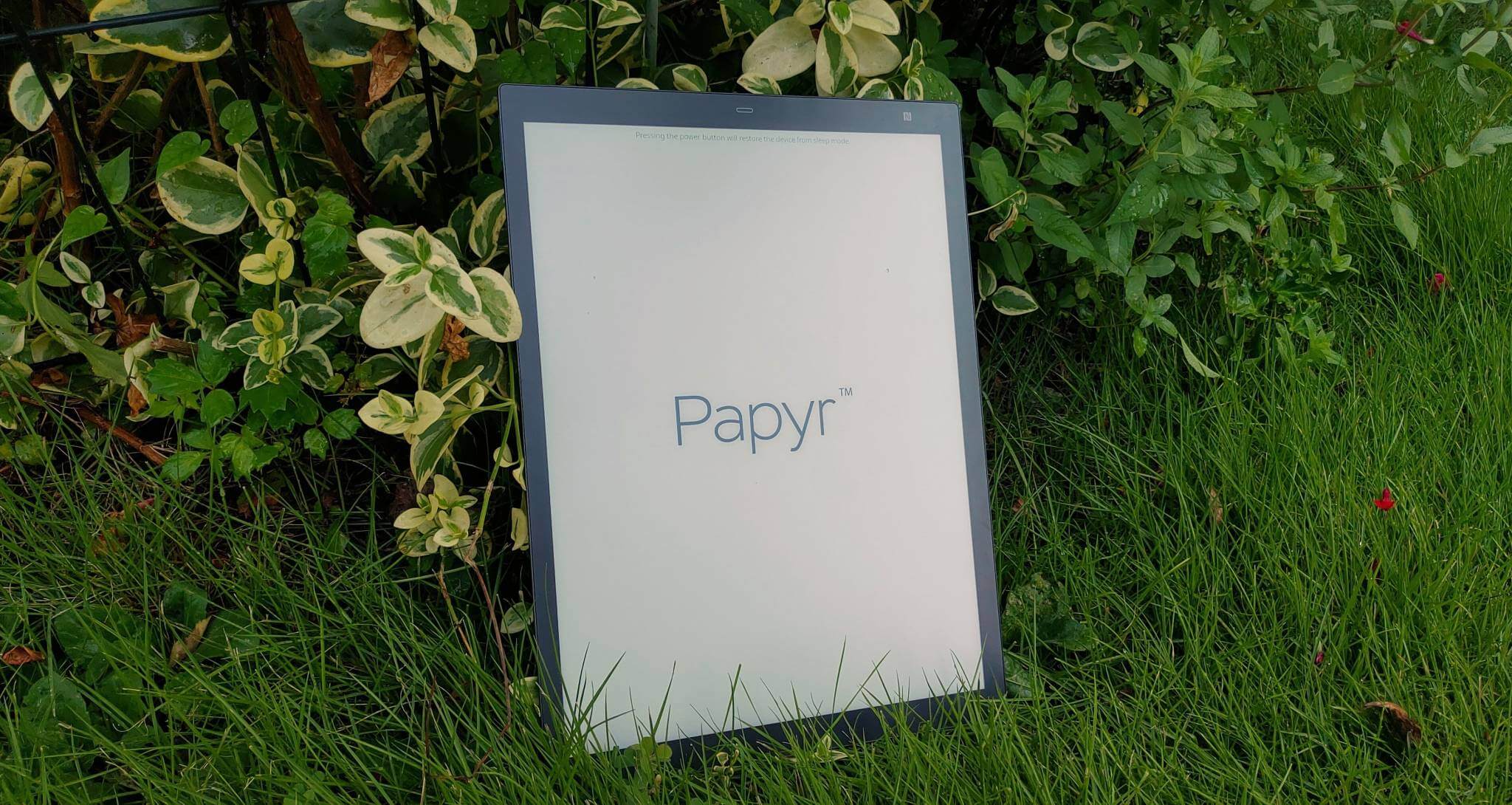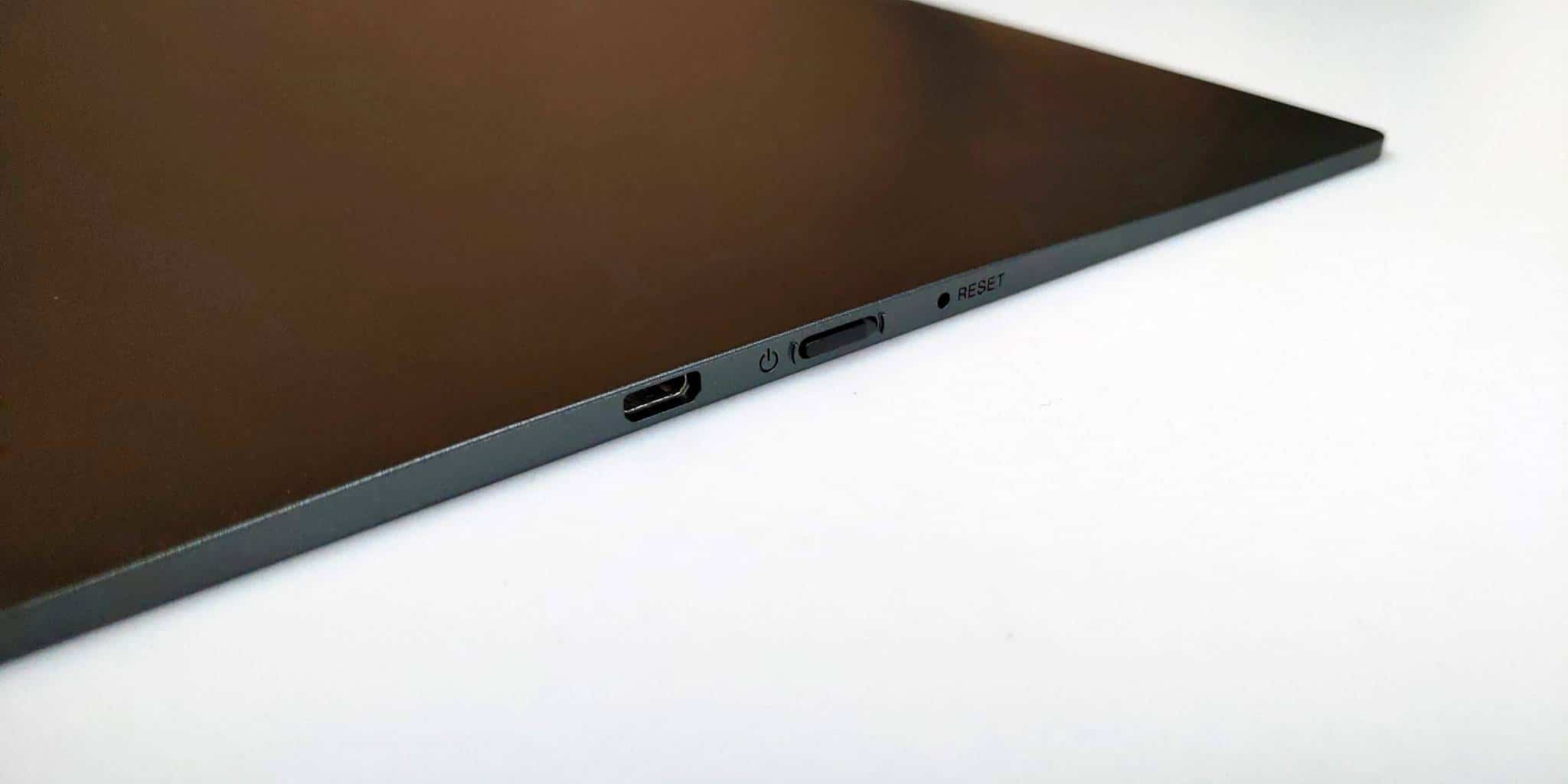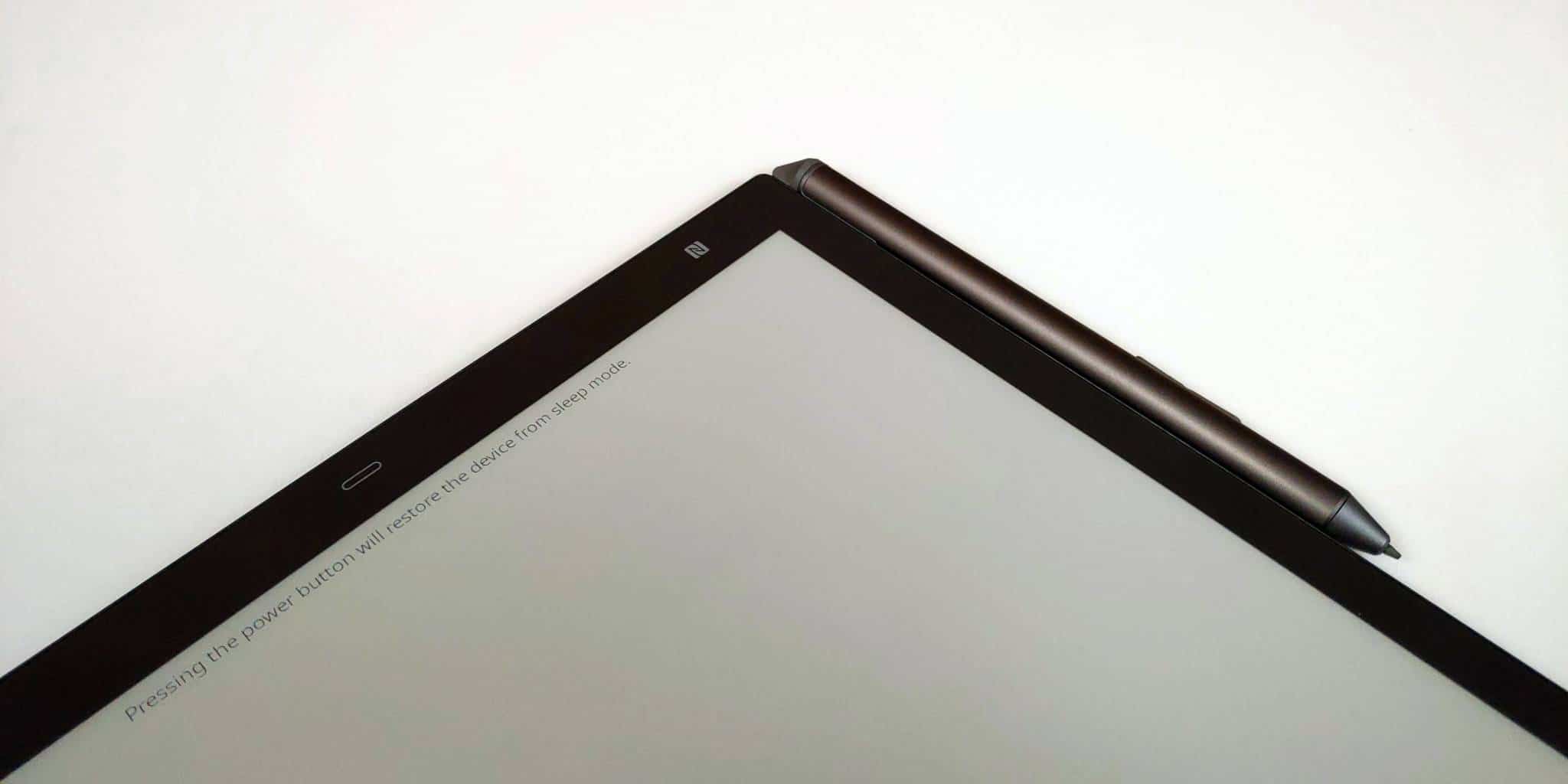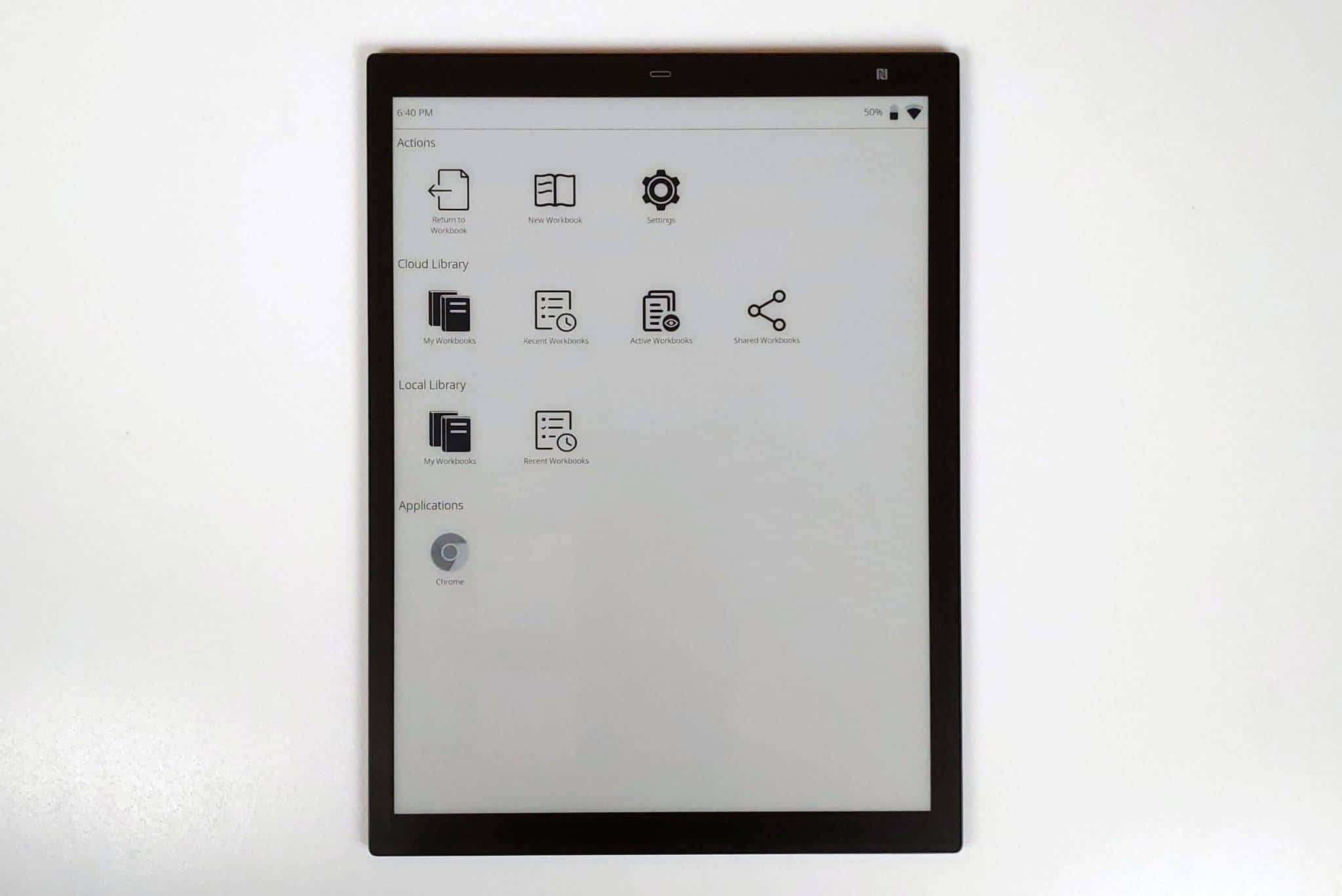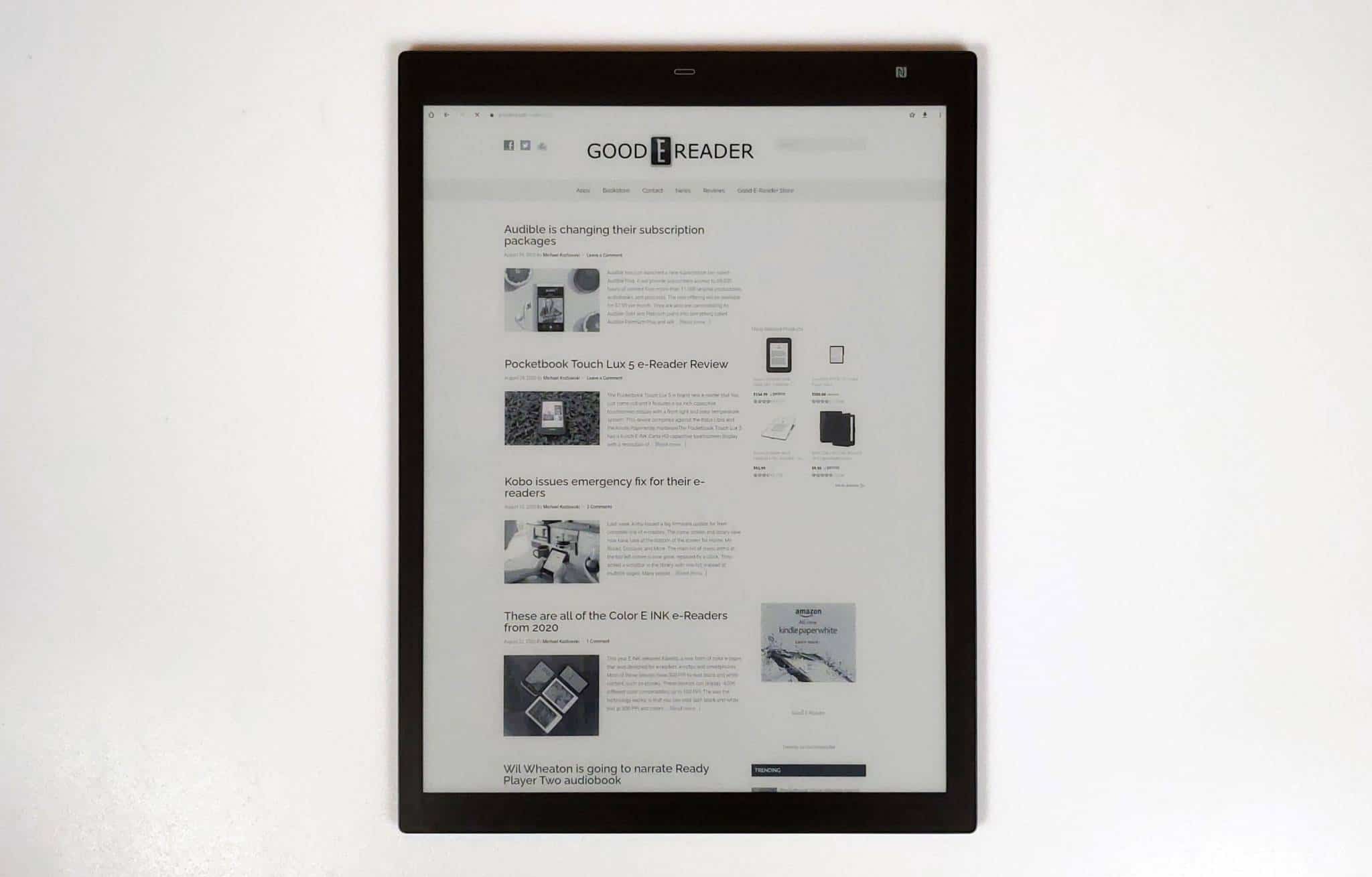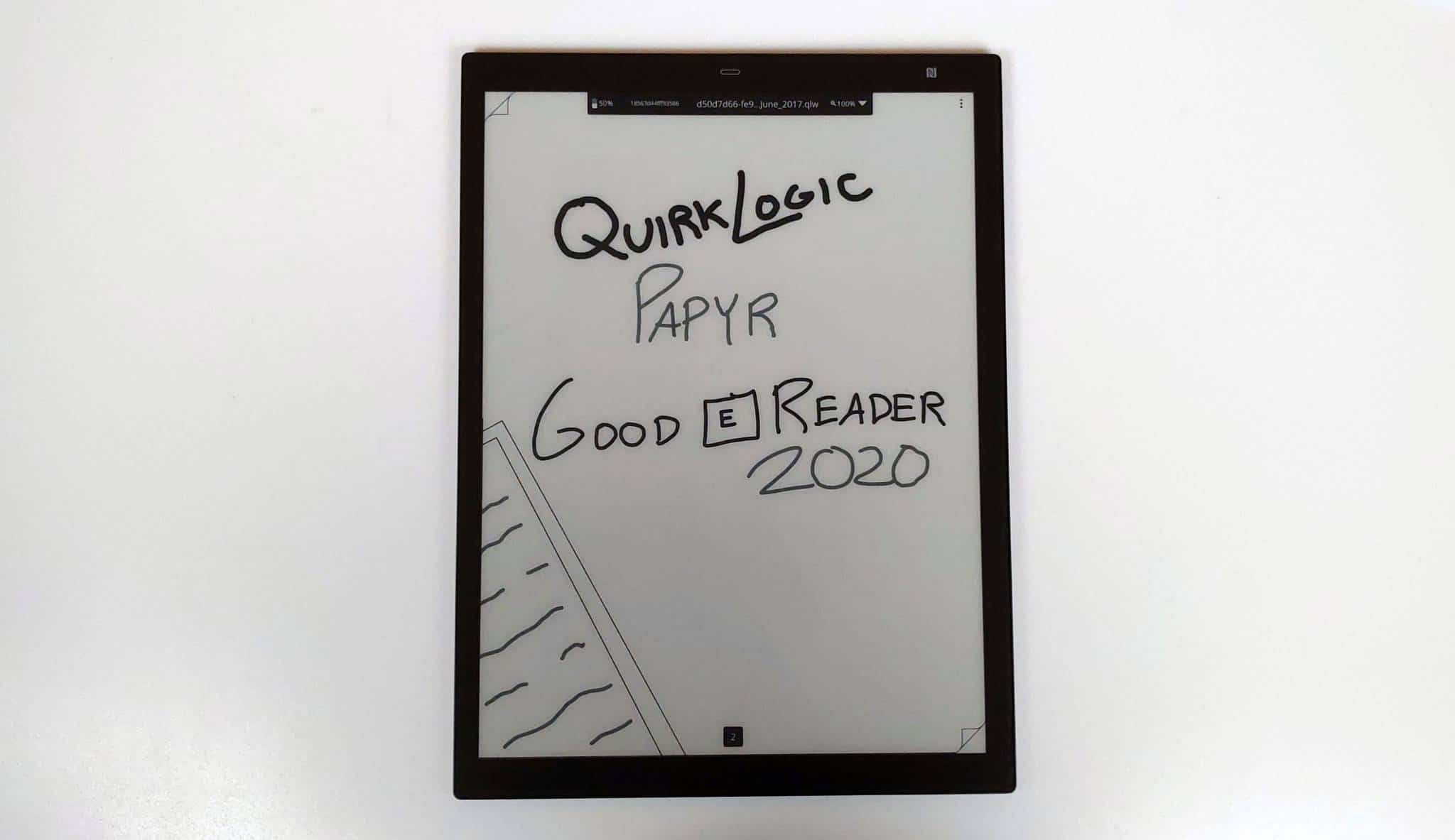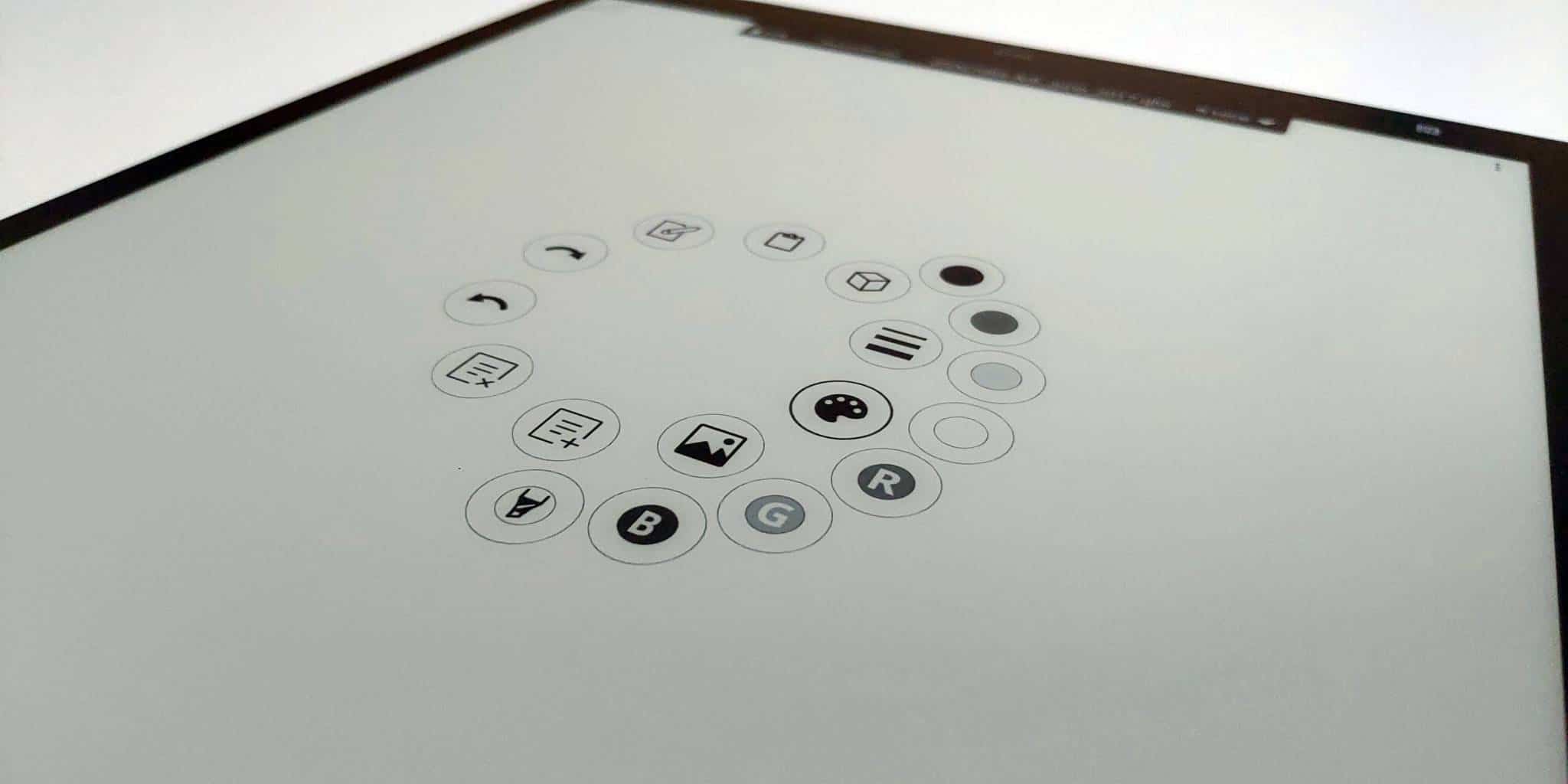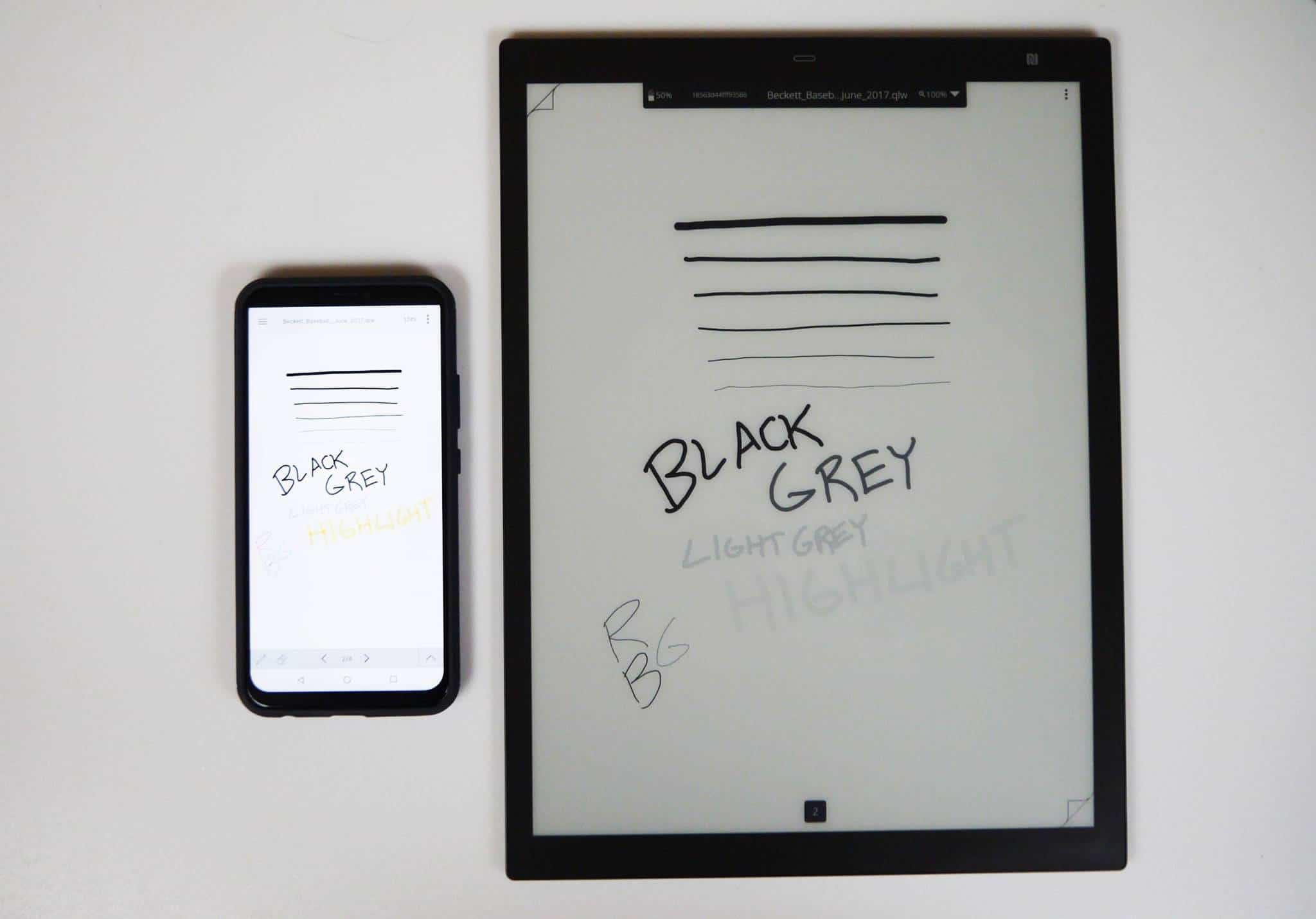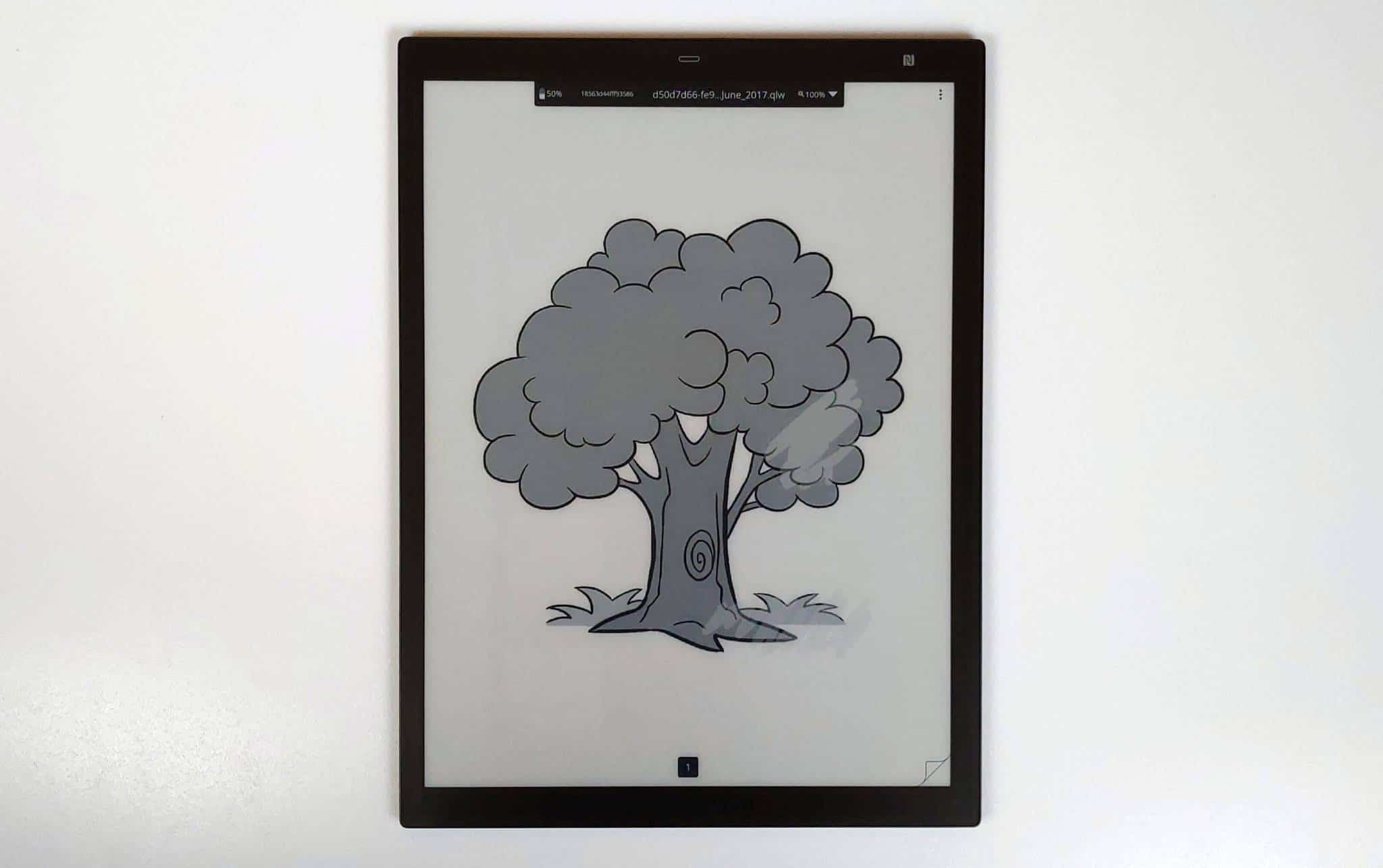The QuirkLogic Papyr is a 13.3 inch digital note taking device that can edit PDF files and take notes. Many other devices on the market can do this too, such as the upcoming Remarkable 2, Onyx Boox MAX 3 or the Sony Digital Paper. This device does something that all of the others simply cannot match, which is the real time collaborative drawing experience.
Hardware
The Quirklogic Papyr features a 13.3 inch E INK Carta HD display with a resolution of 2200 x 1650 and 207 PPI. The screen is completely flush with the bezel, and has a plastic layer, instead of glass. This makes it easier to draw on with the accompanied stylus. It also makes it very light. The body is all black.
Underneath the hood is a Marvell IAP140 64-bit Quad-core IoT Applications Processor and ARM Cortex-A53 CPU, up to 1.2GHz, and has a separate power low-power Cortex M3. It has 1GB of RAM and 16GB of internal storage. It runs Android 8.1 and we attempted to sideload apps, but it created problems with the device, and needed a factory reset. So we do not recommend sideloading apps, until the company fixes this problem via an update.
The Papyr is designed to have synergy with the Quilla, a $4999 42 inch E INK whiteboard. If all of the devices are connected to the same WIFI network or share the same Cloud account, whatever is written on the whiteboard will automatically appear on the Papyr. You can write on the Papyr and have the content displayed on the Quilla, or have multiple Papyrs and have all of the content displayed on all of the other screens, all in real time. Anything that is synced to your screen can be saved in the cloud and referenced later.
The Papyr is basically ideal for individual users who want something where all documents and drawings can be saved to the cloud. Also very ideal for schools in a world where distance learning is the new norm and professors can ensure that all students are actively engaged. A teacher can draw a complex formula on a Quilla whiteboard, so everyone can see it on a zoom session. Students can use the Papyr to answer questions on the whiteboard, by writing on the Papyr and all other students can view everything as it is being written. Quirklogic also has the Quilla Connect app for Android and iOS, so you can view all of the content on your smartphone or tablet, also in real time. So basically one person needs a Papyr and everyone else can follow along with the apps.
The dimensions are 224 mm × 302.6 mm × 5.9 mm (8 7/8 in × 12 in × 1/4 in) and weighs a paltry 349 g (12.3 oz). It has a 2,000 mAh Lithium Ion battery which should give you around four weeks of usage with WIFI turned off.
The hardware itself is basically a Sony Digital Paper shell and internals, but the real benefit about owning one of these is the software, which is really different than the DPT-RP1 and Fujitsu Quaderno A4.
Stylus
Whether you are creating notes or editing PDF files, you will be doing it via the stylus. It is made of cast aluminum and has graphite nibs. The stylus is self-powered and has an internal 1,000 mAh battery. You can easily spend a few hours drawing every day and get around a month’s worth of usagage before you have to recharge it. The top of the stylus can pop off and it reveals a USB port, you can then plug it into your PC or MAC with the accompanied cable and charge it. It takes an hour or two to recharge it from dead to max. The stylus can magnetically attach to the Papyr.
The stylus has two different buttons, one to make highlights and the other is an eraser. The highlighting experience is especially interesting, because not only can you highlight a specific word or body of text, but also you can make highlights over highlights. This is very innovative because you can for example highlight a paragraph, then a specific sentence in the paragraph and then finally a specific word. Each highlight makes the next one a little bit darker and very discernable. There is 11 different highlights that you can make, they can even be superimposed on each other.
There is palm rejection technology on the screen when you are drawing with the stylus, so you can easily rest your hands on palm on the screen and not trigger any UI or screen elements. The stylus does not have pressure sensitivity, so you can press as hard or as light as you want and it will not have any discernible effects. Instead, you have to select the various pen/pencils and sizes to draw. You can pinch and zoom on the screen though, to do some fine shading and detailed drawings, perfect for technical professionals.
Software and Note Taking
The Papyr is running Google Android 5.1, but you cannot load apps or sideload in apps. Google Chrome is installed, giving you a great way to surf the web, access email or read online news publications, such as Goodereder.com. It also has Google Play services installed, Dropbox and Google Drive.
The home screen is quite different than the Sony Digital Paper, when you hit the button, it gave you a dropdown menu to make a note, view a PDF file or access the settings. The Papyr does have a dedicated home, it is broken up into a few segments. Actions, Cloud Library, Local Library and apps.
Actions include Return to the last workbook you have opened, which include notes and shared screen files. New Workbook, which is their note taking functionality and settings. Cloud Library can be setup in the settings menu. You can view all of your workbooks, recent workbooks, active workbooks and shared screens. Anything stored in your cloud account can be accessed via your smartphone or tablet. Local library has whatever drawings and notes you have made, that are physically stored on the device. Apps, only include Chrome for now.
The Chrome web browser is actually pretty great. When you are browsing a website, an A2 mode kicks in, making it easy to scroll up and down. The screen displays a ton of content, you will never need to pinch and zoom to read text. The giant keyboard really takes advantage of the 13.3 inch display, making it easy to type.
Basically you are buying the Papyr to make notes or edit PDF files. The note taking app has a wheel that opens up if you long press the center of the screen with your finger or the stylus. You can access colors, such as red, green and blue. You can’t view the colors on the screen, they appear as various shades of grey. If you import your notes to the cloud or to your PC/MAC, or the apps, you can see the colors. There are also various geometrical shapes, different pen/pencils, thickness, and even importing in your own images. Images and shapes can be resized and positioned anywhere on the screen. There are back and forward buttons, which can be used in lue of deleting, by jumping back or if you made a mistake by clicking back, you can jump forward.
There are 3 little dots on the top right corner. You can view your profile, sign-out, view your library, create a new document, delete a document or a page, save your current drawing or note as a copy, share on social media, export a document, access settings, help or conduct a full page refresh. On the top left and bottom right that can you click on to make a new page or go back a page, great for multipage notes or drawings.
The overall note taking experience is exceptional. There are tons of different ways you can really jot down notes, freehand draw or do something professional, such as designs, character art, or schematics. Importing in images, even transparent ones, is really solid. There is little to no lag when drawing with the stylus, which is great, since the Papyr is using an E INK screen.
The real power with this device is the collaborative drawing system. In our hands on review, we had a smartphone with the Quirklogic app and the Papyr, logged into the same cloud account. On the phone, I could make adjustments to the drawing or import in some images from local storage and it is instantly added to the Papyr. I really like this, and is a major selling point that no other e-note on the market could beat. Chances are you don’t have a deep library of images on your e-note, but you would on your smartphone.
PDF viewing and editing is also a big draw and one of the most compelling aspects about the Papyr is the split screen view and multi page view systems. Multi-page view will open up a PDF file in landscape mode and give you a secondary page. This makes viewing 100 page documents easier to view because you can fit more pages at once on a single screen. Split Screen view allows you to have two different PDF files opened at the same time. You can use the stylus or your finger to turn the pages of an individual document, without affecting the other.
You can view and edit PDF files in a single page portrait view if you want. You can underline, highlight or make adjustments. Anything you edit can be saved locally, viewed on other devices, such as smartphone or another Papyr, and exported to the cloud.
Wrap up
The Quirklogic Papyr retails for $699.99 and the leather case is $59.99. It is worth the money for one of the best e-notes on the market.
The big selling points on why you should buy the Papyr, instead other 13.3 inch devices on the market such as the Fujitsu Quaderno A4, Sony DPT-RP1 or the Onyx Boox MAX 3 is the collaborative, real time sharing of notes, documents and PDF files. I really like the ability to import in images or PDF files from your phone and have them instantly loaded on your Papyr, it really means that you will not have to plug in the Papyr to your PC and transfer in files the normal way.
One of the disadvantages is that you cannot install apps, this is a big draw of the Onyx Boox MAX 3, which also has a more recent version of Android and Google Play, so you can install in all of the apps you want. The Papyr does not have handwriting or text recognition software, nor does it have a microphone for voice dictation to notes, Onyx has all of this, but it does cost a few hundred dollars extra.
I would really recommend the Papyr, it is doing some really innovative things that nobody else on the market is even thinking of doing. The synergy between all of their different products is simply astounding.
Michael Kozlowski is the editor-in-chief at Good e-Reader and has written about audiobooks and e-readers for the past fifteen years. Newspapers and websites such as the CBC, CNET, Engadget, Huffington Post and the New York Times have picked up his articles. He Lives in Vancouver, British Columbia, Canada.

